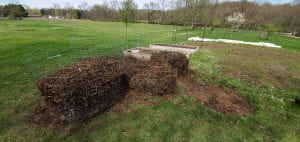– Christine Gelley, Agriculture and Natural Resources Educator, Noble County, OSU Extension

Compost bins can be ‘homemade and handy’ as exhibited by these made from old wire fence by Fairfield County Master Gardener A Lise Ricketts
One of the key elements of healthy soils is the presence of organic matter. Organic matter is the decayed residue of living things. Adding organic matter to the soil in your garden, lawn, or crop field can improve water infiltration and water holding capacity, nutrient access to plants, loosen dense soil texture, and lead to healthier plant growth on the surface. Every citizen has the ability to contribute organic matter back to the soils in their community in some scale through composting organic wastes.
There are many methods of composting that can be employed depending on the amount of waste generated by the household or business. Composting reduces excess deposition of organic wastes in landfills and recycles nutrients naturally by promoting speedy decomposition of organic tissues into soil media. From a coffee can on the counter to composting with worms in a Continue reading
